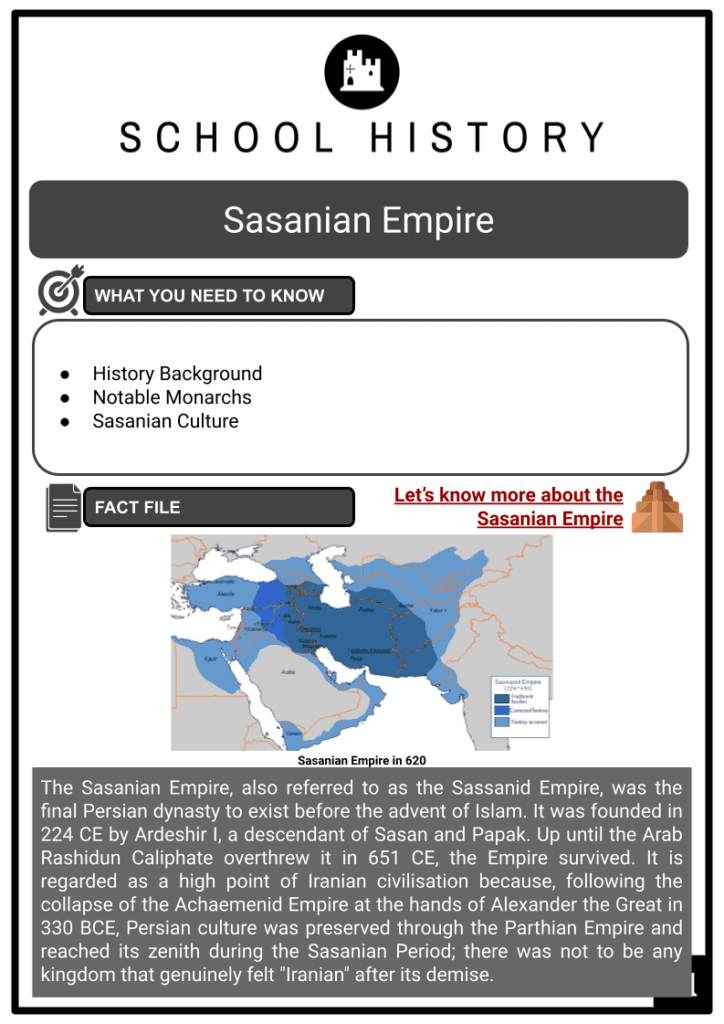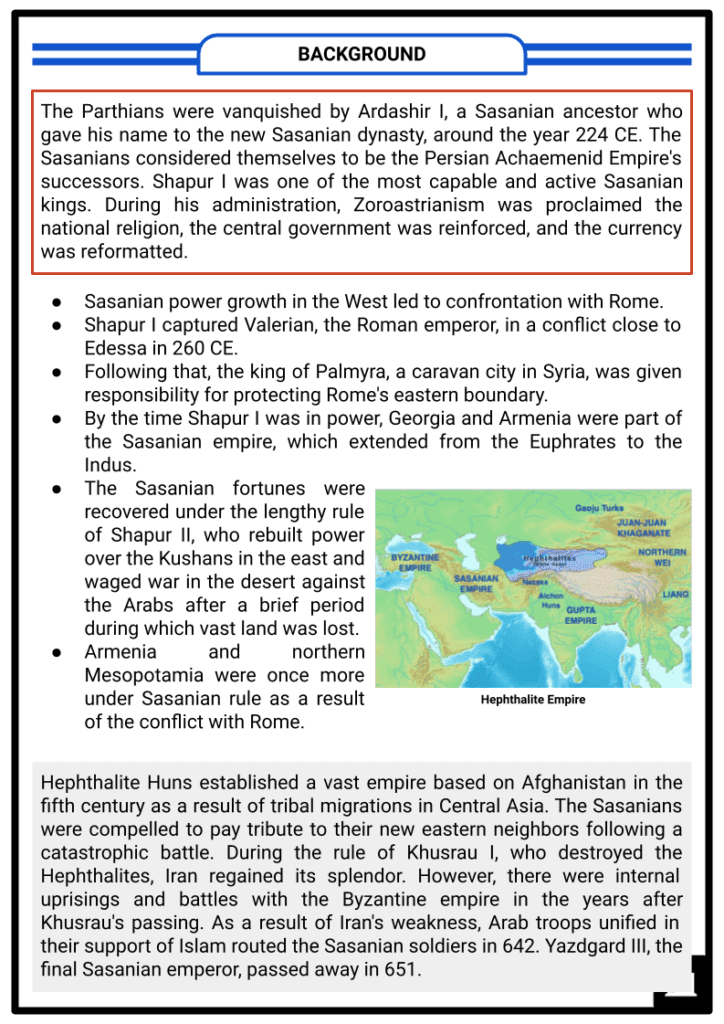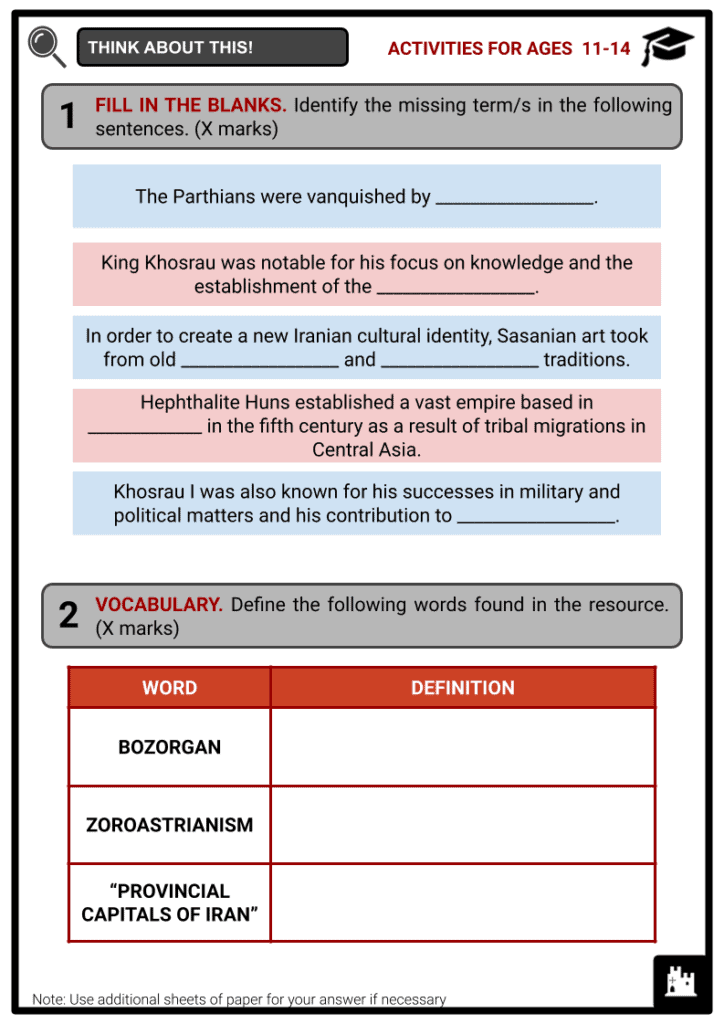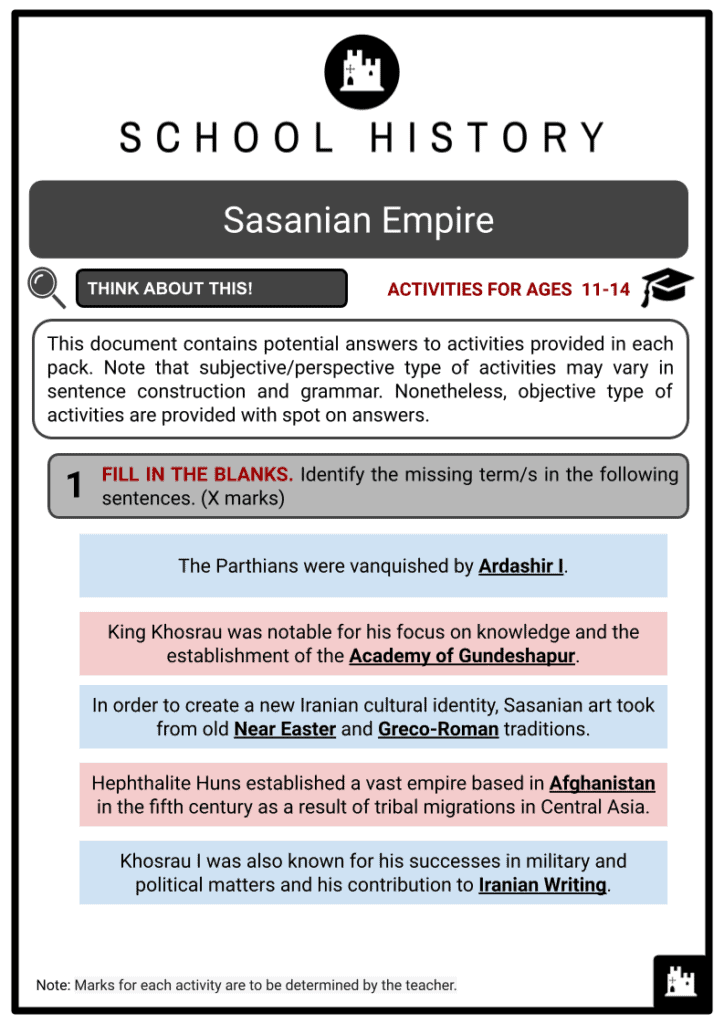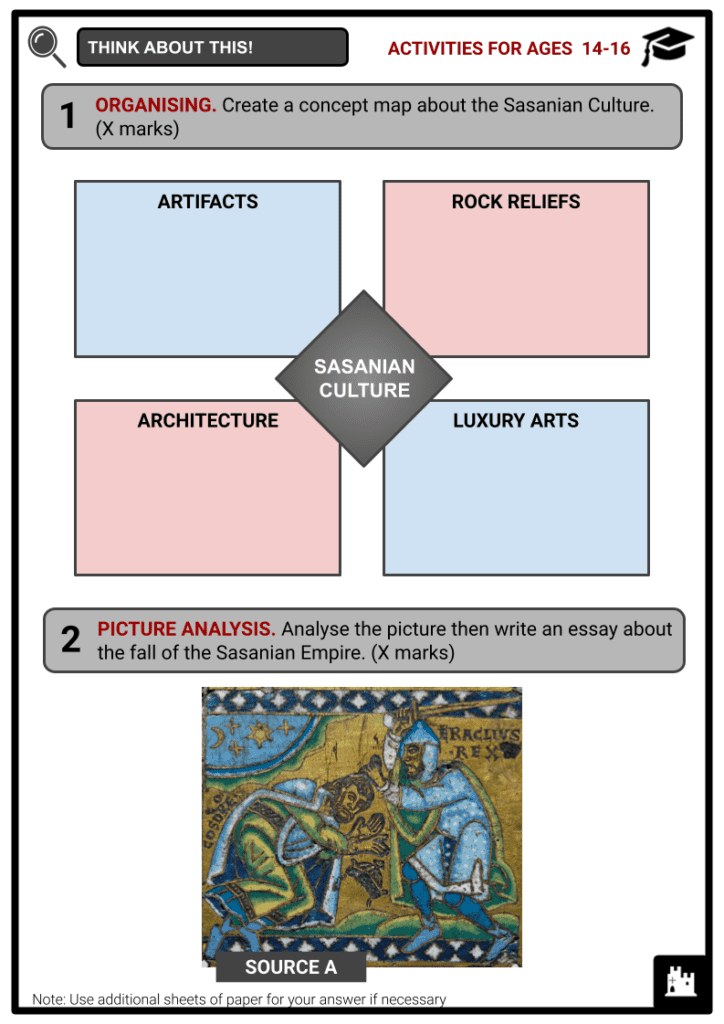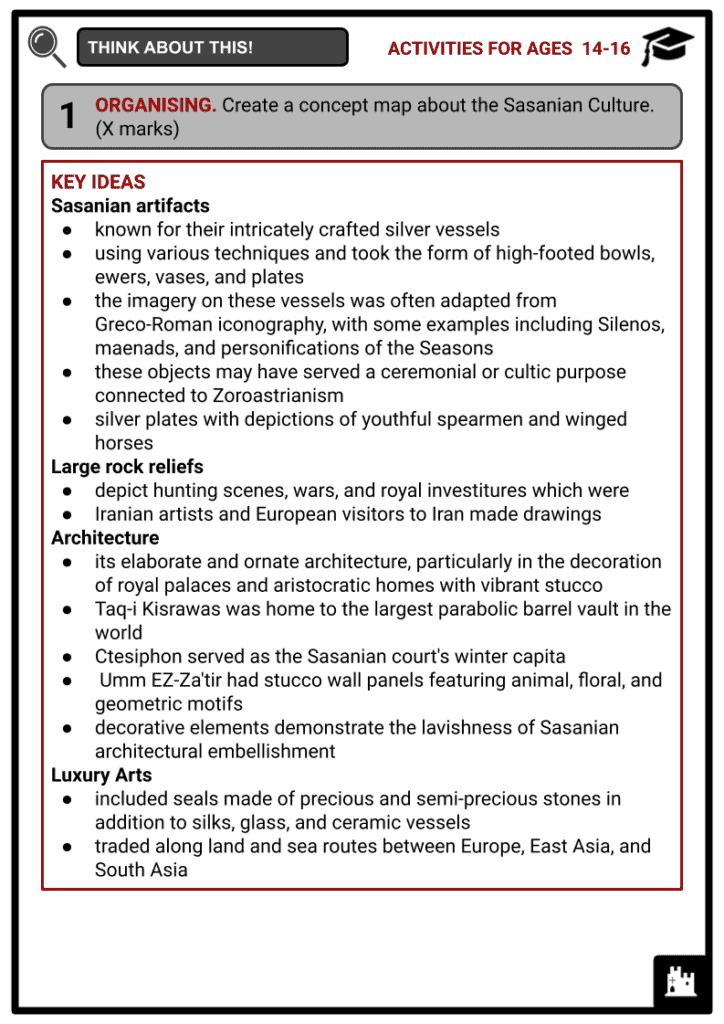Sasanian Empire Worksheets
Do you want to save dozens of hours in time? Get your evenings and weekends back? Be able to teach about the Sasanian Empire to your students?
Our worksheet bundle includes a fact file and printable worksheets and student activities. Perfect for both the classroom and homeschooling!
Summary
- History Background
- Notable Monarchs
- Sasanian Culture
Key Facts And Information
Let’s know more about the Sasanian Empire!
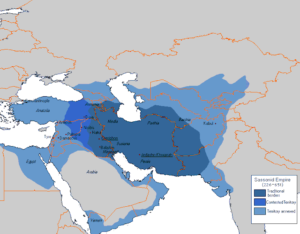
The Sasanian Empire, also referred to as the Sassanid Empire, was the final Persian dynasty to exist before the advent of Islam. It was founded in 224 CE by Ardeshir I, a descendant of Sasan and Papak. Up until the Arab Rashidun Caliphate overthrew it in 651 CE, the Empire survived. It is regarded as a high point of Iranian civilisation because, following the collapse of the Achaemenid Empire at the hands of Alexander the Great in 330 BCE, Persian culture was preserved through the Parthian Empire and reached its zenith during the Sasanian Period; there was not to be any kingdom that genuinely felt "Iranian" after its demise.
BACKGROUND
- The Parthians were vanquished by Ardashir I, a Sasanian ancestor who gave his name to the new Sasanian dynasty, around the year 224 CE. The Sasanians considered themselves to be the Persian Achaemenid Empire's successors. Shapur I was one of the most capable and active Sasanian kings. During his administration, Zoroastrianism was proclaimed the national religion, the central government was reinforced, and the currency was reformatted.
- Sasanian power growth in the West led to confrontation with Rome.
- Shapur I captured Valerian, the Roman emperor, in a conflict close to Edessa in 260 CE.
- Following that, the king of Palmyra, a caravan city in Syria, was given responsibility for protecting Rome's eastern boundary.
- By the time Shapur I was in power, Georgia and Armenia were part of the Sasanian empire, which extended from the Euphrates to the Indus.
- The Sasanian fortunes were recovered under the lengthy rule of Shapur II, who rebuilt power over the Kushans in the east and waged war in the desert against the Arabs after a brief period during which vast land was lost.
- Armenia and northern Mesopotamia were once more under Sasanian rule as a result of the conflict with Rome.
- Hephthalite Huns established a vast empire based on Afghanistan in the fifth century as a result of tribal migrations in Central Asia. The Sasanians were compelled to pay tribute to their new eastern neighbors following a catastrophic battle. During the rule of Khusrau I, who destroyed the Hephthalites, Iran regained its splendor. However, there were internal uprisings and battles with the Byzantine empire in the years after Khusrau's passing. As a result of Iran's weakness, Arab troops unified in their support of Islam routed the Sasanian soldiers in 642. Yazdgard III, the final Sasanian emperor, passed away in 651.
NOTABLE MONARCHS
- The genealogy of the dynasty's founder Ardashir I, who was born in 180 CE, reveals a number of potential ancestors for the Sasanian line. These roots either connect him to the Kayanids or the Achaemenids, two significant Iranian dynasties. The first is a real-world kingdom and dynasty, and the second is a line of mythical rulers with strong ties to Iranian mythology and Zoroastrianism.
- Ardashir I, founder of the Sasanian Empire, prioritised consolidating his own authority, adopting Zoroastrianism as the official religion, and continuing the rivalry with Rome. These changes included centralising power in the Sasanian Empire and integrating Zoroastrianism into the government's administration. Shapur I sought to end the fighting with Rome, which had primarily been focused on Mesopotamia and Armenia, but Shapur I, who succeeded Ardashir I, sought to end this fighting.
- Shapur I was a powerful ruler of the Sasanian Empire who was known for his military strength against the Roman Empire and for maintaining Sasanian dominance in Iran. He signed a treaty with the Roman Emperor Phillip the Arab, ceding control of Armenia to the Sasanian Empire, and he launched successful raids against the weakened Roman Empire, capturing Emperor Valerian and causing a significant blow to Roman morale. Shapur I also initiated a program of urbanisation in the Sasanian Empire, creating many cities according to the "Provincial Capitals of Iran" material, as described in Touraj Daryaee's book "Sasanian Persia: The Rise and Fall of an Empire”.
- Shapur II was chosen as king soon after his birth by the nobles in charge after his father was killed. He demonstrated his ability to govern by committing the Zoroastrian scriptures to paper and expanding the empire's sphere of influence by taking advantage of the Roman Empire's decline.
- Khosrau I was a significant ruler of the Sasanian Empire known for his successes in military and political matters and his contribution to Iranian writing. He implemented tax reforms to strengthen the court by removing the special privileges of the Grandees or Wuzurgans. These reforms modernised the system and made it easier to predict the state's income. These reforms were initiated by Khosrau's father Kavad I and likely contributed to the Sasanian Empire's survival for the next 100 years.
- The Sasanian Empire implemented military reforms to address external threats.
- The empire was divided into four regions, each controlled by a general, to enable quick response to threats.
- The Sasanian kings engaged in wars with Rome, which were mostly favorable to the Sasanians.
- King Kosrau was notable for his focus on knowledge and the establishment of the Academy of Gundeshapur.
- The Academy of Gundeshapur was a center of learning that sought and translated texts from various countries.
- The knowledge gathered and translated at the Academy of Gundeshapur was later inherited by the Arabs and passed on to European culture.
- Yazdegerd III, the final Sasanian ruler, took the throne at the age of just eight. The monarch was really installed in Persis, the Sasanian dynasty's ancestral homeland, rather than the capital because of the tumultuous state of the Empire. He was in power when the Sasanian Empire was invaded by Muslims, and he had to journey from province to province to gather supplies and prepare to face the Arab invaders.
- The Sasanian Empire experienced a series of military defeats at the hands of the Arab armies between 629 and 630 CE, resulting in the loss of several territories including Yemen, Oman, Bahrain, and the client state of Hira.
- The Sasanian army was also defeated in several battles, including the Battle of D'at al-Salasel, the Battle of Madr, and the Battle of al-Qadisiyyah.
- The Sasanian monarch fled to Marw, but was ultimately killed by a miller in 651 CE. Despite the fall of the Sasanian Empire, Persian culture had a lasting impact on the emerging Muslim world.
SASANIAN CULTURE
- The social classes were divided in the same manner as Avesta:
- Clerics (asronãn)
- Warriors (asteshtarãn)
- Administrative Staff (dabirãn)
- Common People (villagers or Wastrioshãn)
- The Sasanian social structure was divided into an elite class and a lower class. The elite class, comprising the royal family, former local dynasties, and military officers, were known as the Bozorgan or "Lords" or "Grandee." The lower class, made up of farmers, artisans, and craftsmen, were unable to advance in social class, and their offspring remained in the same class as well. This inflexibility in the social structure raises concerns about the level of humanitarianism in Sasanian society.
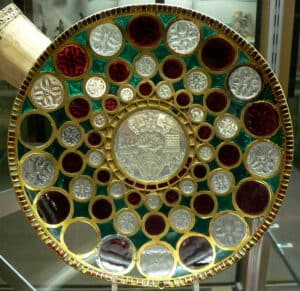
Sasanian Bowl - Zoroastrianism was officially adopted by the Sasanian Empire, which was distinguished by the government's support for it and the way it grew to represent all of Iranian religion. But because of instances of religious dictatorship brought on by the strong relationship between the state and religion, some individuals turned to other religions or superstitions to get away from the oppressive environment. Despite this, the Sasanian administration actively sponsored and preserved religious events due to the strong religious inclination of the Iranian populace. The effect of the fire temples built under the Sasanian Empire may still be felt all throughout modern-day Iran, preserving Zoroastrianism's history.
- In order to create a new Iranian cultural identity, Sasanian art took from old Near Eastern and Greco-Roman traditions. This is especially evident in famous monuments and items related to the royal court. It is challenging to assign dates to many Sasanian structures and pieces of art, in part because there is a dearth of evidence from known archaeological settings. During the four centuries of Sasanian power, trade, invasion, and diplomacy led to the east and west receiving Sasanian luxury arts.
- Sasanian artifacts are known for their intricately crafted silver vessels, which were mass-produced in Iran and Mesopotamia.
- These vessels were adorned using various techniques and took the form of high-footed bowls, ewers, vases, and plates.
- The imagery on these vessels was often adapted from Greco-Roman iconography, with some examples including Silenos, maenads, and personifications of the Seasons.
- It is believed that these objects may have served a ceremonial or cultic purpose connected to Zoroastrianism, the official religion of the Sasanian Empire.
- Some Sasanian silver plates depict youthful spearmen and winged horses, which may be modeled after Bellerophon, Pegasus, the Dioskouroi, and the constellation Gemini.
- The motif of the Sasanian monarch as a hunter became common on official state gifts of silver plates during the reign of Shapur II. These plates often depicted the monarchs hunting animals and could be identified by their inscriptions and crowns. The earliest known depiction of a story from the Persian epic the Shahnama is a silver-gilt plate showing Sasanian king Bahram V hunting rams while displaying royal attributes such as a crown and fillet, a covered globe, and a nimbus.
- The Sasanian Empire is known for its large rock reliefs found in Iran and other parts of western Asia.
- These reliefs depict hunting scenes, wars, and royal investitures.
- Drawings of these reliefs were made by Iranian artists and European visitors to Iran in the 19th century.
- One subject of these reliefs is the equestrian investiture of Ardashir I, who receives the ring of office from the Zoroastrian god Ahura Mazda at Naqsh-i Rustam in southern Iran.
- Most of these reliefs were carved in the Sasanian home province of Pars during the first 175 years of the empire, between the reigns of Ardashir I and Shapur III.
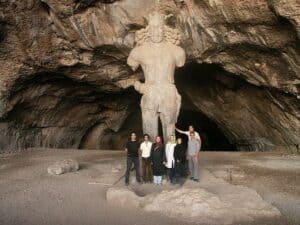
Statue of Shapur I - The Sasanian Empire was known for its elaborate and ornate architecture, particularly in the decoration of royal palaces and aristocratic homes with vibrant stucco. The Taq-i Kisra, a palace in Ctesiphon, was home to the largest parabolic barrel vault in the world. Ctesiphon served as the Sasanian court's winter capital, and the Umm ez-Za'tir, a large residence near Ctesiphon, had stucco wall panels featuring animal, floral, and geometric motifs. These decorative elements demonstrate the lavishness of Sasanian architectural embellishment.
- Sasanian luxury arts included seals made of precious and semi-precious stones in addition to silks, glass, and ceramic vessels. These goods were traded along land and sea routes between Europe, East Asia, and South Asia, and workshops were established in some regions to produce silver vessels with modified Sasanian designs. After the Sasanian Empire was overthrown in the 7th century, Sasanian motifs and styles persisted in early medieval European, western Central Asian, and Chinese art.

